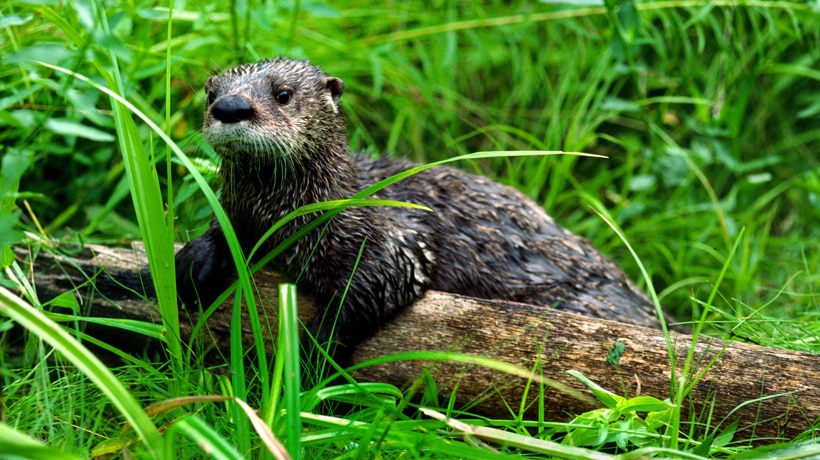River otters in Massachusetts
The river otter is a semi-aquatic mammal found throughout Massachusetts’ lakes, rivers, and coastal habitats. Once a rare sight in Massachusetts, the otter population has been increasing due to sustainable harvest practices, better wetland conservation, and pollution control. The increasing beaver population has also created habitat for otters. Otters are known to be very playful and athletic creatures and are a joy to observe; pups can often be seen with their mother sliding down snow-covered and muddy hillsides and popping in and out of holes in the ice. They use a variety of sounds to maintain group cohesiveness, signal alarm or danger, and express fear and anger.
Description
The largest member of the Mustelid (weasel) family in the Northeast, the river otter has a dark brown water-repellent coat, a lighter colored belly, and silver gray throat. Air trapped within the fur acts as insulation when otters are submerged. They weigh 11–30 pounds and are 35–50 inches in length. Males are slightly larger than females. Their short legs, webbed feet, whiskers and long, thick tail that tapers to a point make them a very efficient underwater hunter, even at night and in dark, murky water. Their ability to close their nostrils and ears while underwater and hold their breath for up to eight minutes, also contributes to their hunting success.
Life history
River otters breed from March to April and exhibit a reproductive strategy called “delayed implantation” that is common to members of the weasel family. This means the fertilized eggs remain dormant in the female’s uterus for 10–11 months after breeding. The fertilized eggs then implant in the uterine wall and begin normal development. The young are born two months after implantation occurs. A female otter produces one litter per year consisting of 1–6 kits, with an average litter size of 2–3 kits. Prior to giving birth, the female retreats to a den near a waterbody with adequate food, shelter and seclusion. Otters do not excavate their own den; instead they utilize abandoned beaver lodges, burrows of other animals and various natural cavities. These natal den sites are occasionally used by the female and her offspring at other times of the year. The young are born blind and toothless and have a silky black coat. They open their eyes at one month old and by three months old they are weaned and can leave the natal area to explore and hunt. Young otters grow quickly and become independent around 6 months old. The female and her offspring stay together for at least 7 to 8 months or until she prepares to give birth to her next litter.
Food, habits, and habitat
Otters are carnivorous and their primary food source is fish—most often targeting slow-swimming species. They will also consume crayfish, snakes, frogs, insects, crustaceans, amphibians, and mammals. They are active day and night, but tend to exhibit mostly crepuscular (dawn and dusk) and nocturnal activity. Otters remain active in winter, using holes in the ice to surface and breathe. They prefer aquatic habitats, such as marshes, lakes, rivers, swamps, and estuaries that provide an adequate food supply, as well as shelter. They commonly use beaver bank dens, log jams, and cavities among tree roots, shrubs, and tall grass as resting sites. The size and shape of an otter’s home range will vary because it is determined primarily by drainage patterns. Otters have few natural enemies. They are essentially safe from predators while in the water, but are vulnerable on land.
Tips for residents
Few negative interactions with people occur, but river otters can sometimes take advantage of sites with artificially high fish numbers, such as hatcheries and stocked ornamental backyard ponds. Ponds can be protected with a 3-inch wire mesh covering. River otters are an important natural resource in Massachusetts. They are classified as a furbearer species, for which a regulated trapping season and management program have been established.
If you are experiencing problems with river otters or have questions, contact your nearest MassWildlife office.
